 |
Dokumentation of work in studio 2014.
|
|
|
Under 2014 och 2015 undersökte jag skillnader och likheter i det konstnärliga skapandet kontra ett pedagogiskt och förmedlande arbete inom konstpedagogik vid Malmö konsthögskola. Jag utgick från mitt eget konstnärskap och mina egna erfarenheter av att arbeta i olika konstpedagogiska kontexter.
Det resulterade bland annat i en uppsats The Dual Gaze and the Logic of Practice som finns publicerad i Malmö Art Academy Year Book 2014-2015. Texten finns att läsa här nedan,(den existerar endast i engelsk version).
|
The Dual Gaze and the Logic of Practice, Madelene Oldeman
|
Introduction
There is a tradition in Western philosophy of definition through opposites. We encounter it in the Ancient Greek concepts of antithesis (opposite, counter-claim) and dichotomia (divided into two). Everything must belong to one or the other, and nothing can belong to both at once. Working as an artist and as an art educator can hardly be considered a case of opposites. However, I experience this very kind of dichotomy in various contexts in my work as an artist, and in my role as an art educator. Despite the fact that an underlying theme in my artistic work revolves around uniting opposites in new forms. This question interests me: can I use attributes of, and differences between, the roles of artist and educator to define my work, in either or both of the two roles?
I will begin by describing the dilemma inherent to art mediation in the section “Can You Have an Artistic Experience While Having the Art Explained to You?” Then, I will proceed to formulate my own artistic work in the section “Tacit Knowledge, Matter, and Spirit — Thoughts on My Artistic Work.” In the third section, “How Has My Artistic Work Influenced Me in Art Mediation Contexts?,” I will investigate how I have handled the dilemma mentioned in the first section as an artist, and offer real-life examples of how I have applied my artistic practice to educational contexts. Here, I discover contexts where the distinctions are blurred, so that an art exhibition can be both an educational workshop and a work of art. Does the difference reside in the expectations of the people involved? I continue this train of thought by offering two examples of artists who have created pieces in which the distinction is unclear and which oscillate between different expectations, in the section titled “Cross-pollinated Forms of Expression.” In the fourth section, “Differences between Working as an Artist and Working as an Educator,” I will examine the ways institutions use artists and educators in their pedagogical programmes and offer further reflections on the differences between the institutions’ expectations and my own expectations based on my experience of working in both roles. As the relationship between the artist / art educator and the institution will be a recurring theme in my reasoning here, I briefly touch upon the current visions art institutions have for their pedagogical programmes in the section “The Defined Audience, the Institution, and Art Mediation.” In closing, I will summarise some thoughts that have arisen during my work on this paper.
When I mention art mediation here, I am mainly referring to it in the context of art institutions. Those projects that were influenced by my pedagogical work and that I ran outside of the institutions are interesting in this regard, as they are independent and can be compared to the pedagogy of the cultural institutions, but I won’t primarily be referring to them. In part, this is because I have more experience within the art institution context, but it is also because I find it interesting to investigate more closely the ways I, as an artist, have worked within the institutions (museums, galleries) and related to their missions. I will mainly be referring to the “Gallery Education” situation, as that has been my main point of entry into art mediation. Professional titles I’ve held in the past include art museum educator, art educator, educator, and curator. In this paper, I will include all of these contexts, as well as the art educational networks that I work in. Together, they express quite well the overall mission of art mediation. This means I will not be defining their differences, either in substantial terms or in terms of status.
My ambition to work as an artist originated during the Hovedskous sculpture programme in Göteborg and matured during the five years I spent at the Malmö Art Academy. This paper is part of my Master of Fine Arts degree, although it is being written several years after my graduation exhibition. My current studio is located in the artists’ collective CirkulationsCentralen (CC) in Malmö, where I was also previously involved in outreach projects, for instance, running CC’s gallery. I have made public decorations and collaborated with a psychiatric clinic for children in Malmö, among other things. However, the main focus of my artistic work for the last few years has been working on large drawings and paintings in ink on paper. My subjects relate to time and space, whereby the pictures exist both as material objects and as mental constructs (another dichotomy that occupies my interest). The latest major exhibition I took part in was for the Royal Academy of Fine Arts prizewinners in Stockholm in 2014, where I showed a ten-metre-tall ink-and-watercolour painting on paper.
|
|
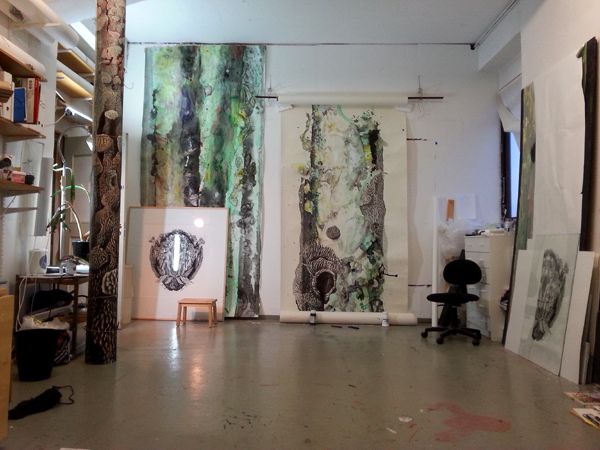 |
Studio at CirkulationsCentralen, Nobelvägen in Malmö 2014.
|
|
I’d like to thank Gertrud Sandqvist, who inspired me to investigate my dual role as artist and art educator in this paper, and Johan Birgander, who has supported me in my work by acting as a conversation partner and linguistic advisor.
|
Can You Have an Artistic Experience While Having the Art Explained to You?
The importance of spoken and written language for mediating art became very clear to me when I agreed to begin working with art mediation. In mediation or education contexts, understandings of and reflections on art are based largely on the spoken word. For instance, this happens in situations where a conversant person conveys her or his knowledge and ideas to an audience that is listening and pondering in silence, or in a dialogue between the expert and the audience, where everybody experiences and reflects together and everybody takes part in formulating and producing knowledge. These are the most commonly encountered forms of art mediation in art galleries and museums. And this is also what most people will think of when you mention art mediation: a guide giving a tour of an exhibition, telling the visitors about the works and the artists. But can you have an artistic experience while having the art explained to you?
This is not a new question. It is one that Anna Lena Lindberg raised in her groundbreaking doctoral thesis, “Konstpedagogikens dilemma: historiska rötter och moderna strategier” (The dilemma of art mediation: Historical origins and modern strategies), from 1988. One problem art encounters, according to Lindberg, is that it is regarded as incomprehensible, which is problematic from an art mediation standpoint, as it gives the educator an explanatory function. Another problem is freedom of interpretation, which implies every point of view is equally valid. The mere fact that controversy exists over not only the notion of what constitutes good art but also what constitutes art at all adds further complication to the teaching of artistic understanding.
The ways that the role of the art educator and the missions of the art institutions have changed are connected to changes in attitudes to teaching and knowledge over time. Lindberg demonstrates this by describing how the dilemma of art mediation today lies in its wavering between two incompatible attitudes, which she refers to as the “educational approach” and the “charismatic approach.”1 The former is related to the Enlightenment’s ideas about teaching, in which humans are regarded as recipients of knowledge who, once enlightened, will “rise towards the light.” The transfer of knowledge occurs from above to below, without any consideration for the differences and respective resources of the recipients. In this way, the educational approach objectifies the recipient, in treating him or her as a vessel to be filled with knowledge.
On the other hand, the charismatic approach is based on a concept borrowed from Pierre Bourdieu, who speaks of an artwork’s “charisma.” This concept is connected to an ideology that romantically claims that since the art experience has to do with emotion rather than reason, the piece will speak to viewers irrespective of their education and social standing. Since imagination and intuition are innate, methodical learning contributes nothing in the way of essential qualities. The problem here is that educational activities are not able to promise deeper understanding of art. The charismatic approach only acknowledges the presented stimuli and then leaves viewers alone with their experiences and conclusions. This approach promotes absolute subjectivity, unlike the first one.2
Helene Illeris, professor at the University of Agder in Norway, has also researched the problems of art mediation and has numerous years of practical experience in the field, having worked at Statens Museum for Kunst (the National Gallery of Denmark) in Copenhagen, among other places. In her article “Vad kan man lära av samtidskonsten?” (What can we learn from contemporary art?), she sees relationally oriented contemporary art as offering a solution in what she refers to as “metareflection.” Here, she suggests a dual gaze that allows both interaction with the work of art and reflection on the way one chooses to interact with it. This would make an educator’s explanations superfluous, as there is no need to have somebody stand next to you to tell you what is happening while it happens.3
As an example of metareflection in this sense, of the dual gaze that Helene Illeris advocates, I’d like to use the artwork Choice (2010) by the Brazilian artist Laura Lima, which was shown at Bonniers Konsthall during the autumn of 2014, and which touched me on several levels. This piece wasn’t weighed down by text or explanation; instead, it was shrouded in mystery thanks to its elimination of all description. Lima defines herself in relation to her predecessors in the Brazilian art scene of the ’60s and ’70s, like Hélio Oiticica, Lygia Pape, and Lygia Clark. Just like the work of these pioneers of the neo-concrete movement, her art is a kind of total art, in which the body plays an important role. But while her predecessors used methods that were intended to dissolve the boundary between the art object and the viewer, Lima, according to her own conceptualisation, uses the body as just one material among others, as a kind of “living sculpture”: “everything, bodies and objects, are on equal terms, without a hierarchy.”4
In Choice , darkness is the most tangible material of all. A host who is standing outside the entrance to the piece asks me to leave my bag and mobile phone outside. Only one person at a time is allowed through the heavy drape, and I have to wait awhile for the visitor inside to exit until it’s my turn. When the host gives me the go-ahead, I push the drape aside and step into dense darkness. I have no idea how large the room is, or if there is anything in there. The drape closes silently behind me, and the darkness paralyses me at first.
It’s very interesting to study yourself and your own reaction to Choice. The dual gaze is inevitable as the content of the piece is your own reaction to it, in such a naked way. My eyesight didn’t adapt to the dark even after I had waited for what felt like several minutes.
Blind, I take a few steps into the room, but I realise I might not find my way back to the entrance if I go too far. I back up and begin to follow the walls instead, which are dressed in the same heavy fabric as the entrance. I feel my way along the cloth with my hands. But will I find my way back if I follow the wall? Does it matter if I find my way back? It sounds like there’s somebody breathing in the dark, feels like there’s something alive in there. I have to remind myself that I am in an established public art institution and that I’m hardly in any serious kind of danger. But I still don’t want to encounter another person in here. Different strategies for exploring the room and avoiding discomfort begin to run through my mind, and I am constantly aware of my own actions and inactions. I face my own fears in total darkness.
|
Tacit Knowledge, Matter, and Spirit — Thoughts on my Artistic Work
In my practice in the studio, I don’t give art mediation and its inherent dilemma any thought at all. For instance, if I were to apply a dual gaze, or metareflection, while painting in ink on paper, it would mean I was trying to produce an analysis at the same time as I was creating the picture or piece. That’s not what I’m after. I tend rather to seek freedom from logical thinking in the moment of creation. Liberatingly, the practical experience and the direct non-verbal interaction are so much faster and easier that an analytical voice would have a hard time keeping up. This voice would probably also lack the words and concepts needed to describe the events that occurred.
“Are there things that the arts — certain arts — can express that science cannot? How can we make room for art in cross-disciplinary work, so that it can help fill in the blanks in areas where rational science can’t go?”5 Bo Göranzon wrote that in the introduction to philosopher Allan Janik’s book Cordelias tystnad — Om reflektionens kunskapsteori (Cordelia’s silence), from 1991, which is about the epistemology of reflection. Janik speaks of “tacit knowledge,” a concept that has been overlooked within the field of epistemology. He uses examples from fiction as case studies by which to explore real-life phenomena.
Michael Polanyi was the first to use the concept of tacit knowledge in a scientific context. He claims a large portion of our knowledge of the world cannot be stated fully in words: “We can know more than we can tell.”6 In his 1966 book, The Tacit Dimension, he gives as examples our ability to recognise a certain face among a number of others, without being able to state exactly what it is that lets us determine that it is that particular face.7
In her book Art beyond Representation: The Performative Power of the Image (2004), Barbara Bolt claims there is knowledge that is based on practical experience rather than linguistic experience. She quotes Bourdieu on the relationship between practice and logic:
Practice has a logic which is not that of the logician. This has to be acknowledged in order to avoid asking of it more logic than it can give, thereby condemning oneself either to wring incoherence out of it or to thrust a forced coherence upon it.8
Bolt explores how the artist responds physically to encountering the material, and, among other sources, bases her theories concerning the unique logic of practice on Martin Heidegger’s theories of art and the concept of “handlability.” According to Bolt, Heidegger claims human beings don’t primarily understand the world by contemplating it in their thoughts; rather, we are only able to understand the world theoretically after we have experienced it through action.9 Heidegger uses a hammer as an example:
The less we just stare at the thing called hammer, the more actively we use it, the more original our relation to it becomes and the more undisguisedly it is encountered as what it is, as a useful thing. The act of hammering itself discovers the specific “handiness” of the hammer. … No matter how keenly we just look at the “outward appearance” of things constituted in one way or another, we cannot discover handiness. When we just look at things “theoretically,” we lack an understanding of handiness. But association which makes use of things is not blind, it has its own way of seeing which guides our operations and gives them their specific thingly quality.10
Bolt develops her theories on the relations between body, object, and material further, and goes so far as to claim that the material can be regarded as the co-creator of the artwork, and that visual arts cause actual material effects. She contends art does not just represent, it effects.11
Could it be my extroverted work situation, where I speak of and reflect on art, that causes me, in my own art, to seek to retract into the body and explore unconscious processes, the liquid, and the non-verbal? It’s as though I’ve sought to shield my own artistic practice from my own educational gaze. “If you can accept refraining from understanding what you do, you will reach much further in what you do.”12 Marcel Duchamp said this on French radio in 1960. (These six radio programmes can be regarded as shining examples of interesting French art mediation, in which arts journalist Georges Charbonnier interviews Duchamp in depth on topics such as his relationship to surrealism, Dadaism, history, and language.)
For me, working on art is my own way of relating to life and existence. It is as though I can never find time to process things unless I get to stop time by working in the studio.
One hundred fifty-two times two metres. Three hundred grams per square metre. It’s on the floor. Fingertips running along the grain, its texture rough, it feels strong, a little tough. The paper is a large skin, each corner weighted down. Will the ink stay on the surface, or will it be sucked into it and become its body? The host, the body of Christ. I sometimes feel like eating paper. The window’s open, it’s raining outside, and the paper is swelling from the humidity, spreading itself out over the concrete floor. It makes me think of scar tissue, the picture as a wound on swelling tree skin. I have filled a large bucket and some smaller plastic tubs with water, and prepared and set out my ink. I have taken out brushes, soft round ones, abused hard ones, feather-light ones, and my finely pointed ink pens. Everything is standing or lying around me, in order. A ritual or a ceremony, perhaps; a sacrifice. But still quite mundane, with the cars whizzing by in the street outside. All this moisture that is going to be passed through the white net, the skin, and the traces it will leave. I’m going to sift the picture out, both carefully and recklessly. I’m going panning for picture, kneeling with the hard, cold concrete against my shins. The ink smells of ink, a little like soil. I haven’t stretched the paper out to tape its edges down, and I’m not going to wet it nicely and evenly all over its surface. I just get started right away with the big round one made of goat and pony hair. Just water that I brush onto the paper skin, painting invisibly, making puddles. The paper contracts in some places and expands in others. It’s moving, alive. I have to adapt my will, because the pools take their own shapes. Hills rise up in the dry areas, and valleys are created in the wet ones. I continue to drip black ink into the valleys. Black fireworks explode, the ink spreads, making rings quickly. I think of a boy who visited the museum, how he exclaimed: “I’ve made an amazing discovery!” I remember how elated he was by this, and the words he blurted out. “There are lots of kinds of black or I mean there are lots of different black colours in black!” His eyes and his fingers messy with paint. It has stopped raining. I drip even more ink into the puddles, and vague, amorphous shapes appear. The darkness moves, and is sucked into the blotchy skin like grey shadows. Grey next to black. Next to wet white. Shapeless grey blobs run in front of the amorphous bodies, and the peaks sink from their weight. In this way, the differences are evened out, if only somewhat.
|
|
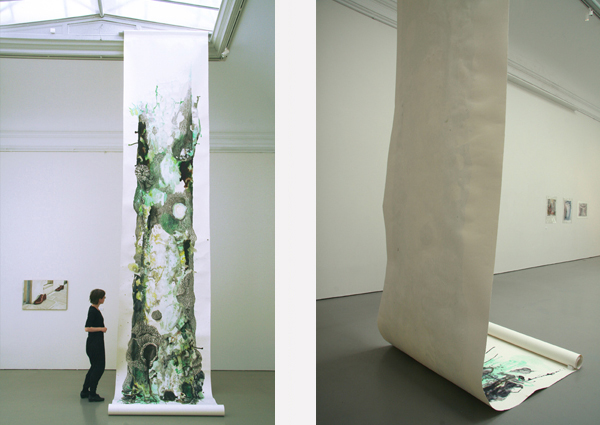 |
Untitled, ink, watercolour and acrylic paint on paper, 1,52 x 10 metres (floor to ceiling, 6,33 metres). From the exhibition The Prize Winners of the Royal Academy of Fine Arts 2014, Stockholm.
|
|
In 2008, I began to work with ink on paper. Ink drawings and ink paintings related to nature and the body, often very large pieces that interact with the space and the architecture, which they either fit into or struggle against. In the beginning, I only used black ink. What interested me at first was letting ink drawings and ink paintings inhabit a tension between being a picture on a flat surface and having a tangible physical presence as objects in space. My drawing has always had an element of modelling to it, and in my work on these ink drawings or paintings I tend to find my approach is more closely aligned with sculpture than with painting.
|
|
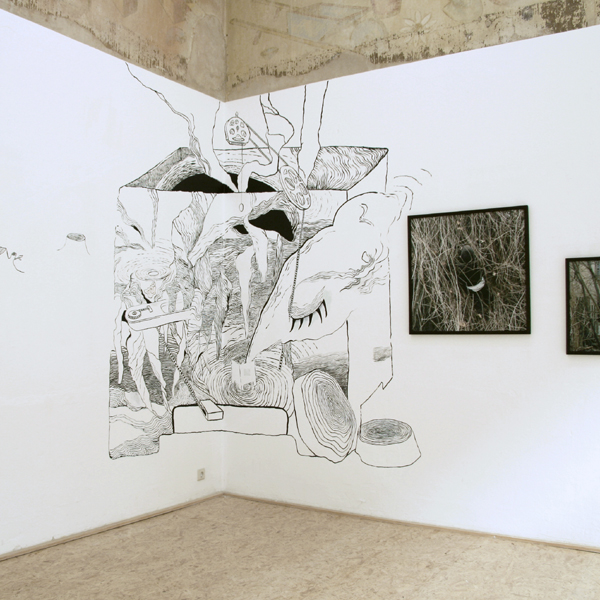 |
One night in Copenhagen, acrylic paints (height of ceiling: 3,5 metres) If things do not happen Bautzner 69, Dresden, 2006.
|
|
|
|
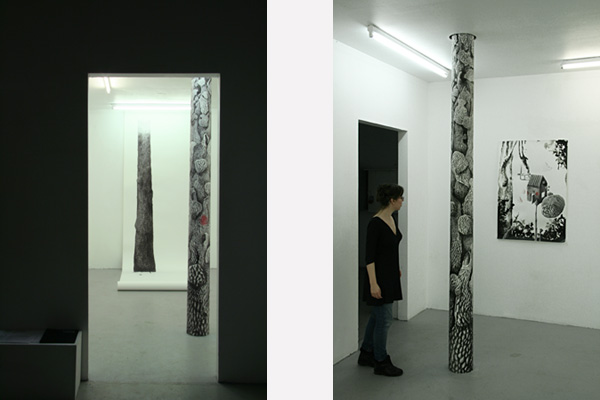 |
The Vertical Experience, CirkulationsCentralen, Malmö, 2011.
|
|
|
|
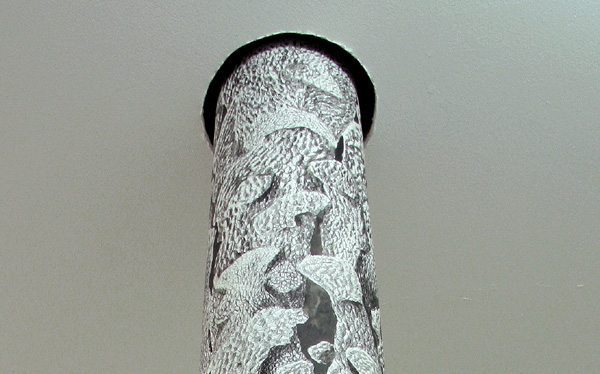 |
The Vertical Experience, CirkulationsCentralen, Malmö, 2011.
|
|
It might be because of my own personal relationship to Christianity and its separation of body and soul that I’m so interested in the distinction between spirit and matter. I want to figure these concepts out. I want to formulate how the distinction works, and dissolve it while doing so. In Stenarna i själen — form och materia från antiken till idag (Stones in the soul: Form and substance from ancient times until today), Sven-Eric Liedman describes how the Chinese concepts of matter and spirit have differed from Western ones historically. In the Chinese tradition, they are not distinctly separate concepts.13 Chinese artists like Zheng Chongbin, Li Huayi, and Qiu Zhijie awaken my curiosity because of their relations to the picture and to the material. All three of them work in the borderlands between Western and Chinese artistic traditions.
|
|
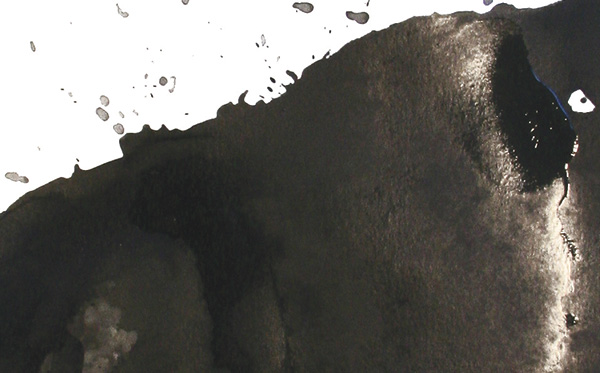 |
Detail from The Inkling, ink and watercolour on paper, 70x150 cm, 2008.
|
|
|
|
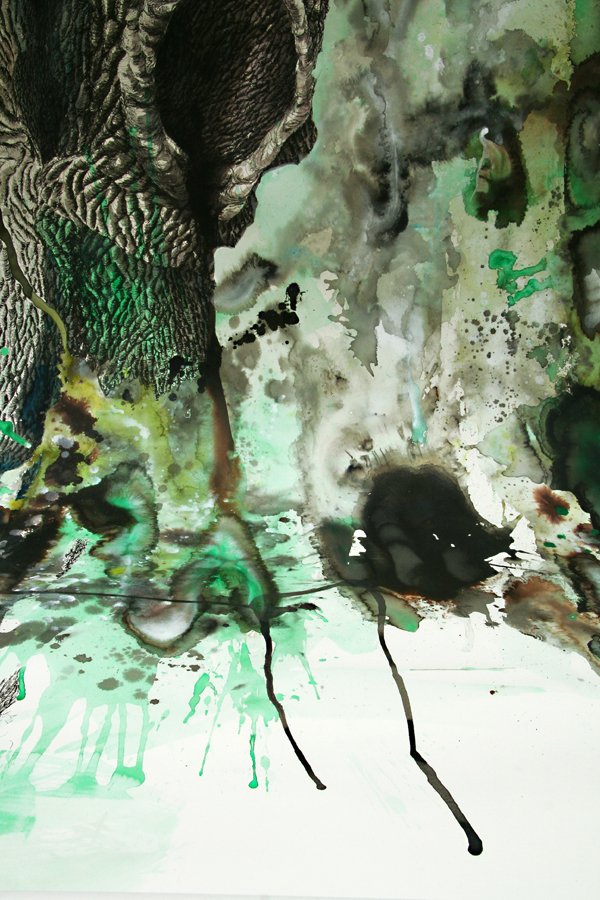 |
Detail from Untitled, ink, watercolour and acrylic paint on paper, 1,52 x 10 metres. From the exhibition The Prize Winners of the Royal Academy of Fine Arts 2014, Stockholm.
|
|
Just like Zheng, I am interested in ink as a material, as matter, rather than merely as a carrier of gestures or forms. Zheng mixes white acrylic paint into his Indian ink paintings, using the white acrylic both as a colour that reflects certain wavelengths of light and as a physical material, or body. This in turn affects how the ink is experienced, so that it also becomes a tangible material in his works. In traditional Chinese ink paintings, the white sections consist of unpainted surfaces, like in watercolour paintings. That is, the absence of a body, or a diluted one.
As a continuation of this material way of relating to ink and paper, I have proceeded to explore drawing and ink painting as an action, as performed by the body. There are different materials that offer differing amounts of resistance; for example, the liquids can be thick and viscous, or thin and runny. I’ve been looking to examine the relation between mental and bodily processes in the creation of images, especially in connection with ink painting and its material aspects. In this regard, I have tried things like drawing based on habitual motions and gestures, whereby the pen or brush makes tracks across the paper to catch the movements. The tracks appear as pictures when we look at the paper, and we might even be able to feel the movement. Drawing with both my left and my right hand at the same time is another method that can tease pictures out of the actual motions. I will describe this method, which I also used in a workshop entitled “Parallellteckning” (Parallel Drawing), below.
Polanyi considers perception to be a case of tacit knowledge: “By illuminating the ways in which our bodily processes play a part in our perceptions, we will be shedding light on the bodily basis of all thinking, including the most advanced creative abilities humanity possesses.”14 He continues to describe how our bodies are the primary instruments of all our external knowledge, whether it be intellectual or practical, and how the use of tools can constitute a sensory extension of our bodies.15
A body of work that I think would be interesting to study more closely based on the concept of tacit knowledge is Lygia Clark’s. In the film Memória do Corpo from 1984, which is one of few documentations of Clark (who died only a few years later, in 1988) performing a Structuring of the Self session, the body is extended by the use of objects/tools in a therapeutic context. Clark’s artistic practice developed in a way that led her to abandon the traditional art scene and enter into new and unexplored contexts, such as the development of new therapeutic methods. In this half-hour film, Clark initially describes the objects she uses and the responses she gets from various clients. Then, we get to follow a private session, a kind of psychotherapeutic process. Clark’s undressed male client, Paulo Sérgio Duarte, who is a Brazilian art critic, lies on a bed as Clark places, presses, and rubs her “relational objects” against his body — plastic bags filled with air or water, padded cloth, and rocks in net pouches. She covers his eyes with cloth pouches filled with sand and polystyrene balls and places large seashells over his ears. She drips honey on his lips and shines a torch at them to create the sensation of warmth. It’s interesting to hear Duarte describe his experiences when the session is over. He’s clearly moved by the whole thing, and speaks of internality and externality: “I’m all skin. Surface. It was as if I was all surface … the place where we meet the world.”16
Laura Lima says that she creates works of art outside of herself, and unlike Clark and her Structuring of the Self, Lima doesn’t regard her art as being about creating a subject. She describes it instead as “a risk, a poem a mystery.”17 I feel that Lima’s art is related to the concept that Janik and Polanyi call tacit knowledge. It seems to me that Lima is experimenting with a non-verbal experience in which subjective experiences are obvious (co) creators of the artworks.
I have drawn without looking, have drawn based on gestures or movements, and have developed a method for drawing with my left and my right hands simultaneously. This exploration of my physical relation to the material and the image is an aspect that is taking on a more significant role for me, not just in my own artistic practice but also in the art mediation context as well. This knowledge is not based on language, but on a practical or physical experience that Barbara Bolt, Michael Polanyi, and Allan Janik each refer to in their own ways.
|
|
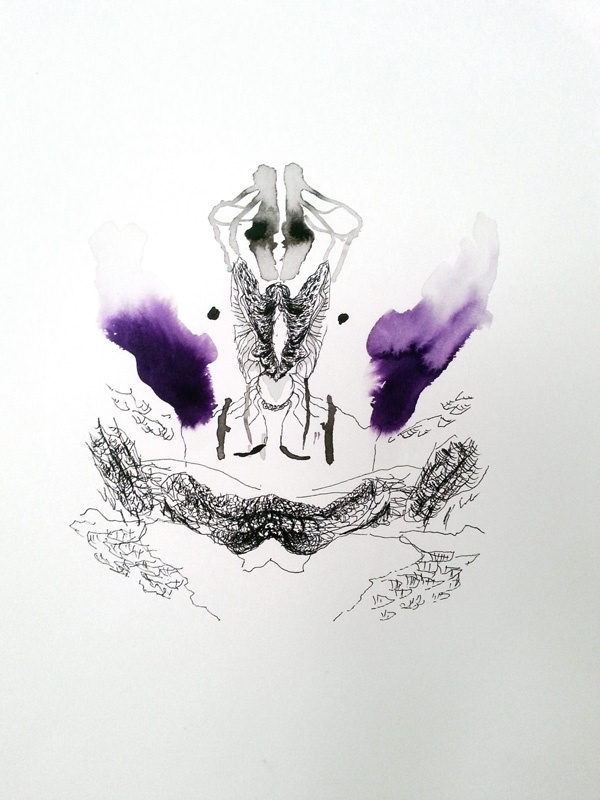 |
Ink drawing with left and right hand simultaneously, 21 x 30 cm, 2013.
|
|
|
How Has My Artistic Work Influenced Me
in Art Mediation Contexts?
When I began taking on art mediation assignments and was expected to perform the conventional task of giving gallery talks (as an art educator who gives tour of the works in an exhibition), I felt the need to come up with my own approach to it. I came to this purely as an artist, having no previous education relevant to, or previous experience of, art mediation. Later on, I studied the subject at university, and in this context the problems that I had encountered in practical situations were validated. I was occupied by the dilemma that Anna Lena Lindberg expressed (can you have an artistic experience while having the art explained to you?), as well as the fact that there is a tendency in the context of the gallery talk to regard an artwork as the final product of a narrative. If the artistic experience never occurs, if the art fails to “happen,” and leaves the narrative to stand alone, the work being shown (on this occasion) at the institution tends to be the final product of the narrative.
|
|
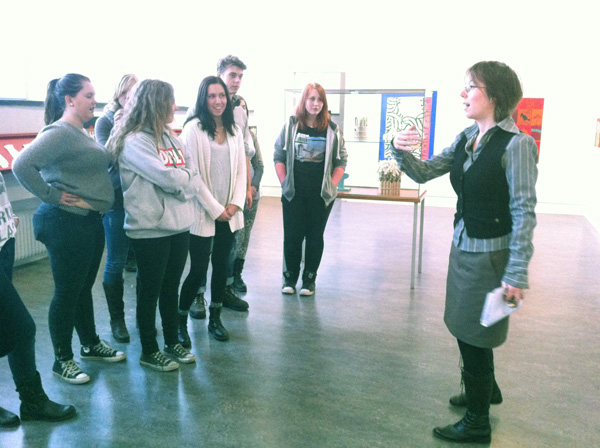 |
Me and a group from Östersjögymnasiet at Ystad Art Museum 2013.
|
|
The fact that I worked as an artist and had studied art practically for many years when I gave my first gallery talks affected how they turned out. Initially, I treated them like studio discussions, in the same way that I had experienced them at the art academy and later with my artist colleagues. Treating the situation like a studio discussion automatically places the work of art in a context in which it is related to an artistic process. It invites everybody to take part in its creation. The pieces are no longer finished products that can be explained in terms of a linear narrative. This method works best with children and young adults, who will often be more interested in expressing their own views than adults in a gallery talk context.
What I am referring to when I use the term “studio discussion” is a conversation whereby an artist has the opportunity to have his or her work analysed from several different points of view, to achieve better understanding of where the artistic process is headed. The discussions can be based on different notions such as form, content, technique, presentation, history, emotions, effects, facts, and so on. It’s a way to occupy oneself with one’s art. In the gallery talk context, I use the studio discussion as a method for reflecting on artworks together with an art audience, in which everybody is invited to contribute their own reactions, thoughts, and analyses based on who they are and what their experiences are. This method, so familiar to me, also gave me the physical and mental calm I needed to dare linger in the quiet moments, when everybody’s own internal reflections get the time they need. Of course, this method is open to criticism in the sense that the piece is actually “finished”: the artist has made all her or his choices, and decided to present the work as it is. It is no longer in the studio.
When I began taking on educational assignments, I was very keen to avoid ending up explaining art, but I am less strict about that today. I also used to be more faithful to the specific pieces and artists, and their own explanations of their practices. Today, I can customise the talk for the group of visitors in front of me and use the artworks and artists’ practices as tools to reach them, or bring up some theory of mine, or a theory from somebody else. Sometimes, it almost feels like I betray the artworks. I feel torn between loyalty to the artworks and their existences within what is loosely referred to as the “art world” and the visitors’ expectations, or, sometimes, disappointment or suspicion.
Bolt claims that the great focus that has been placed on the finished piece at the expense of the artistic practice has produced a gap in our understanding of art as a process, in both research and theoretical work within art studies. She quotes art historian and art critic Bernard Smith, who claims that art studies are based on four keystones — identification, classification, evaluation, and interpretation — and takes this as confirmation that art studies is interested in data, not in actions. The artistic process is treated separately. And, according to Bolt, this means that knowledge specific to the discipline is lost, as well as definitions of fundamental concepts that validate it. 18
I have wanted to explore whether or not there is a practical experience-based method for reflection on art in education and mediation contexts. One area in which I have attempted this is the traditional format of “gallery talk followed by work in the studio / workshop,” which is commonly offered to children and young adults at art galleries and art museums. A very simple method for working in this context is to just reverse the order of events: start in the studio, where the kids get to explore and form a physical connection with a material and to their own interactions with pictures and reality, and do the visit to the gallery where the established artworks are shown after.
The difference compared to beginning with the gallery talk and then working in the studio or workshop is quite striking. You notice it right away, just in the way the kids enter the gallery space. Kids that have been allowed to create first are much more confident; they claim to know what the art is about, express opinions about the artist’s intentions, and feel at home to a much greater degree than kids who get the traditional treatment.
|
|
 |
Photos from different workshops 2014 and 2011 at Ystad Art Museum.
|
|
|
|
 |
Tape Graffiti (2013) at Ystad Art Museum. A workshop and an exhibition. Photo: Lena Persson, Educator.
|
|
|
|
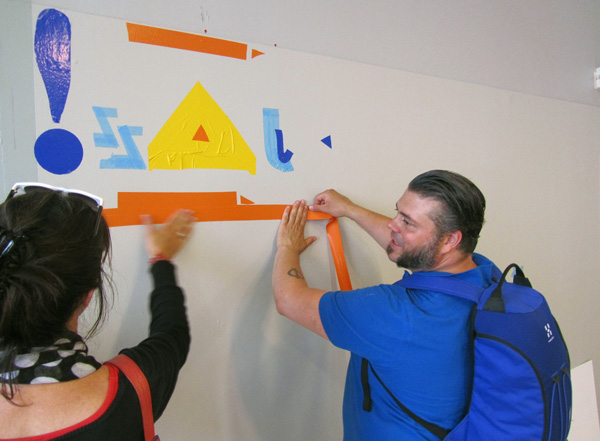 |
Tape Graffiti (2013) at Ystad Art Museum. A workshop and an exhibition. Photo: Lena Persson, Educator.
|
|
|
|
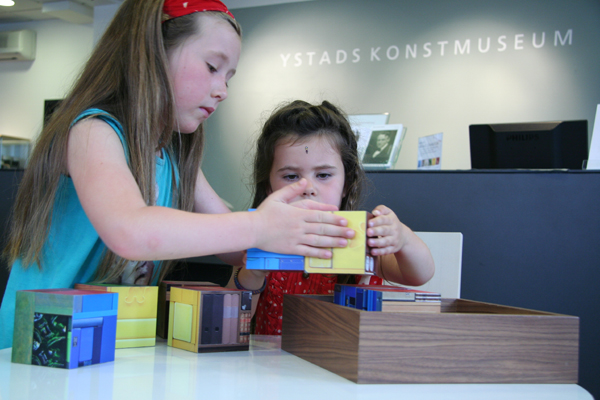 |
The cube puzzle created together with Michael Johansson’s exhibition at the Ystad Art Museum 2011. Idea and concept: Madelene Oldeman. The photos of the sides of the cube puzzle: Michael Johansson. Top: Bobby and Minnie, two visitors to the Ystad Art Museum.
|
|
Meditating before giving the gallery talk is another method I have tried. My plan was to see if the calm and focus that meditation instils would have an effect on the visitors’ encounter with the artwork and on their experience of the exhibition. Unfortunately, the time constraints in this kind of work made it impossible for me to draw any real conclusions. It’s virtually impossible to make time for meditation. I’ve also attempted short meditation exercises with visiting school classes. In these scenarios, there is a great difference between groups taught by teachers who already use meditation in their teaching and those who don’t. This is something I’d like to investigate closer.
After having worked as an art educator for a couple of years, I noticed a problem that was quite widespread in schools — they couldn’t tell illustration from art. This in turn causes further problems when the schools visit art institutions to see exhibitions, whether they are historical or contemporary. Since setting yourself up as someone who can determine what is illustration and what is art is controversial, in 2009 I decided in my role as an art educator to compose a two-hour workshop in which I took a clear stand on issues and claimed that there were right or wrong answers. The person who decided if something was illustration or art was me, the presenter, like an autocratic ruler. The workshop was designed for adult educators who work with children and young adults.
The participants, after a brief presentation in which I used example images to define art and illustration, were given three assignments: to create an illustration, to create a work of art, and to explain the differences between them. It was all tongue-in-cheek to some extent, but this was the first time I tried not being an open-minded and understanding art educator, and acted more like a strict schoolteacher. My goal was only to get the message across. The participants who succeeded at one or both of the assignments were asked to line up on one side of the room, and the ones that failed were lined up on the other side. I gave clear explanations as to why they had succeeded or not.
These workshops were a lot of fun to do, and they generated a lot of interesting discussions in the groups. Our roles were questioned as a result of my clear enactment of the role of the person in the know. If I hadn’t been an artist myself, it would have been more difficult to make such explicit judgments regarding what is or isn’t art. I was criticised to some extent, but my judgments may have seemed more acceptable because most of the participants knew that I was also an artist. In this case, the workshop was given in the context of my art mediation work, and the question came to me: How clear, and how controversial, can the attitudes I express in my role as an art educator be? As an independent educator, sure, but what about when I’m representing an institution?
Another way for me to work in art education and mediation has been to organise a special kind of workshop that is also an art exhibition, in which the participants join in the creative process. I don’t know which direction the process will take ahead of time; I have to adapt to what happens along the way. Initially, this was a method for achieving an experience through practical work, with the art audience as its target audience, whether it was children, young adults, or adults, or a mixture of the three. These workshops have started to inch closer to actually being art. And this is a case in which the difference is very difficult to explain. But first of all, it has to do with expectations. There’s one kind of expectation, mostly residing with the institutions, in relation to art exhibitions, and another expectation in relation to an educational project that involves audience participation. There are also different expectations among the art audience and the schools when they are the target audience. My approach as an organiser becomes important. Am I invited in my capacity as an artist? Am I invited as an artist who is being asked to create an educational context? Or am I an educator at an institution, in an art mediation role?
|
|
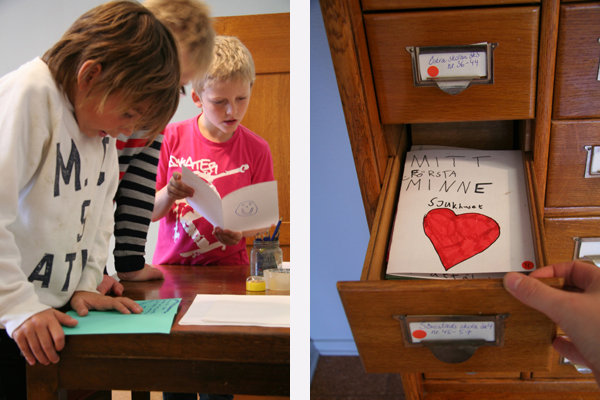 |
The project Marked Memories - To Remember a Place (2011) at Ystad Art Museum was both a workshop and an exhibition.
|
|
To organise a workshop that doubles as an exhibition you need to consider the location and the time: how long the exhibition or workshop is supposed to go on for, on the one hand, and how much time the individual participants will be investing, on the other. Is participation going to be loosely structured, on a drop-in basis, or will there be a set time? The first participants will have a different experience than the last ones if the exhibition / workshop lasts for a long time. Will there be an educator on site, or not?
“Parallellteckning” (Parallel Drawing) (2013) was a workshop intended to make the participants focus on drawing as a physical activity and reflect on the connections between mental concepts and the body’s behaviour as they drew. In this context, I was invited in the capacity of an artist developing an educational programme. The workshop was a drop-in event that ran for two hours, and the participants could come and go as they pleased. I decided to use methods that I have employed in my own artistic practice and test them on other people. The origin of the exercises in “Parallellteckning” was a problem that developed in my drawing hand, my right hand, which made me unable to use it for some time. So, I began to draw with my left hand instead. I noticed that this had an effect on my drawing — not just in a physical sense, but mentally as well. When my right hand recovered, I continued to experiment and began using both my left and my right hands simultaneously to draw, as well as creating pieces by alternating between my hands, or only using my left hand. The workshop was an attempt to challenge both physical and mental habits and conceptions, as well as the participants’ limitations and capabilities. I did this by influencing the physical circumstances and the mental attitudes of the participants as they were drawing. The materials were felt-tip pens, liquid ink, brushes, and paper. Most of the exercises were performed by individual participants. There were also group exercises for two or more participants that investigated openness and attentiveness to others in relation to one’s own desire to get to decide.
|
|
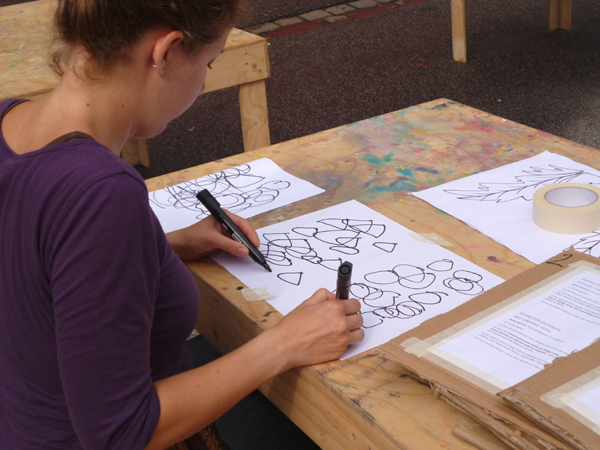 |
Workshop at The Malmö City Festival 2013.
|
|
|
|
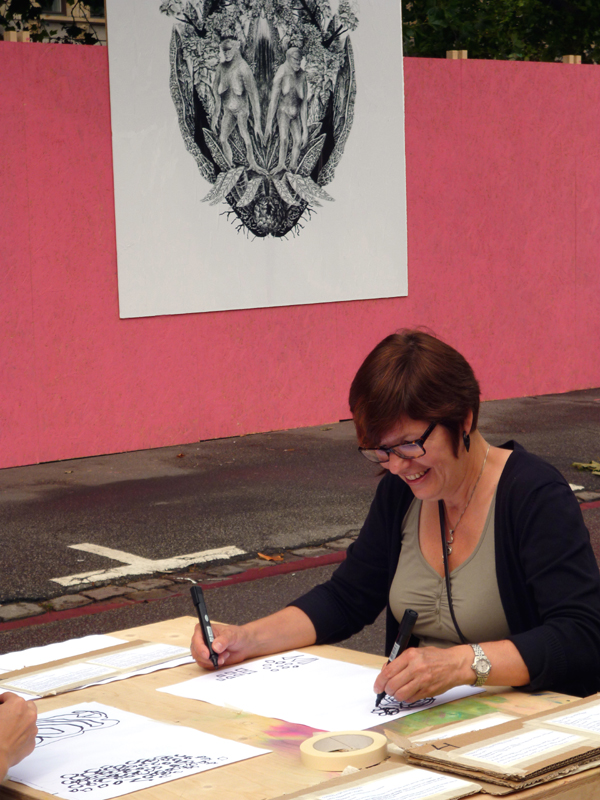 |
Workshop at The Malmö City Festival 2013. In the back: Drawing with Left and Right Hand.
|
|
The biggest discovery I made in this workshop was the variety of ways in which the participants responded to the exercises that were seen as physical or mental tests or challenges. Some found pleasure in trying out new approaches and letting go of their habitual control, while others couldn’t take it and aborted the exercise. Children up to the age of about five saw no point at all in the workshop, while many of the older participants, from the age of fifty or so, began to construct their own theories. I was told several personal stories about how injuries or illnesses like strokes had forced people to produce new solutions to problems they faced in their everyday existences and in their work. At one workshop, I met a boy who was able to draw two different pictures at once, one with each hand.
|
Cross-pollinated Forms of Expression
In the preceding section, I described workshops that were also exhibitions as examples of situations where it can be difficult to draw the line between an educational project and a work of art. The distinctions blur and the projects oscillate between different sets of expectations in a kind of cross-pollinated form of expression. An artwork that is interesting in this regard is Them, by the Polish artist Artur Zmijewski, which was first shown at documenta 12 in 2007. This emotional video, which you could see as education, social experiment, and documentary film all in one, was part of Zmijewski’s installation at documenta 12, and is a violent example of art created in a workshop context in which the participants were less than absolutely safe.
Zmijewski gathered four groups of adults, all with very strong opinions regarding nationalism, communism, gender identity, and religion. None of these participants were artists. Each group consisted of four to five people. He ran a workshop with these people and filmed the whole process. On large white canvases, they got to spray-paint symbols and images that they considered representative of their opinions as a group. Among other things, they painted a church; the word “Poland” in Hebrew; Szczerbiec (The Jagged Sword), a symbol of Polish nationalism consisting of a sword and a ribbon coloured like the Polish flag; and the word “freedom.” After a while, Zmijewski had the groups trade places, and each group continued on a painting started by one of the other groups. Here, the similarities with an art exercise in school end, and the conflict takes over. The participants altered the expressions, added to them, and spray-painted over certain elements in order to make the other groups’ paintings conform to their own values. After a while, their gestures took an aggressive turn, as the participants became upset and aggrieved at having their messages altered. Their actions turned into a struggle over representation, a war fought using symbols in place of weapons. The pictures were torn down, rebuilt, and destroyed once more. Holes appeared right through the canvases when certain participants felt compelled to obliterate specific parts of the painting. Zmijewski didn’t step in and interrupt the event, instead letting the participants escalate on their own terms.
The video has many interesting dimensions, politics, history, and education among them. Viewing the video is distressing, as the different groups’ behaviour keeps growing more stereotypical, and they begin to take their task of winning the struggle very seriously. They show no desire for dialogue, and their actions get so violent and destructive that it actually seems like the participants could be in danger. The whole thing ends when a fire breaks out in the room, the final statement made by some of the participants.
Another example that I find to be an interesting cross-pollinated form of expression is Lima’s The Abstraction — an art museum run by children, which was shown at the Lilith Performance Studio in Malmö in 2014. In the work, Lima let a group of children, aged around ten, select artworks from the collections of Ystad Art Museum and Malmö Art Museum, which were then arranged by the children in the Lilith space. Her only rule was that they had to choose abstract works. The children were then left to run the museum themselves, with eleven-year-old Lo taking on the role of art museum director, with an office of his own. The children charged entrance fees, ran the café, and gave exhibition talks, in which two of the children showed the artworks together and expressed their opinions about them, at set times every day. The children took these tasks very seriously, and the most striking thing was their desire to emulate adults in their roles. They become a mirror, revealing structures and hierarchies. For instance, the way the boys in the gallery talks I participated in took over the talk more and more, while the girls stayed in the background, was striking. Because I work in the world that the children were mirroring, it provided many eye-opening moments.
The reactions to The Abstraction have been interesting. In the press, the piece was mainly treated as an educational project that focused on how children like to act like adults. Martin Hägg addresses the issue from more of an art critical perspective in his article “Barn förklarar det abstrakta” (Children explain the abstract) in the online journal Omkonst. He interprets the piece as a political statement: “The Abstraction is a leftist statement along the lines of ‘art for the people.’ An example of a sympathetic ethos of inclusion that has, since the 1960s, increasingly become the main focus for most of the more respected art institutions.”19
I feel that many writers and critics failed to appreciate the value of The Abstraction as a work of art, because Lima’s chosen expressions were so similar to the methods of art mediation.
|
Differences between Working as an Artist and Working as an Educator
What, then, are the differences between working as an artist and working as an art educator? What do the art institutions think of this relation? Ayesha Ghanchi sees artists taking on two roles in the art education and art mediation contexts within art institutions today. She has mainly studied the Tate Modern’s historical use of artists between 1970 and 2010. The two roles she has picked out are the established artist, who exhibits her or his art, and the educational artist, who works as an educator. Here, according to Ghanchi, the institution shows an interest in the artistic process of the established artist, but not in that of the educational artist. The use of the established artist in the educational programmes has changed over the years, as the perception of art mediation has shifted from a teaching attitude towards the visitor to one that focuses on the visitor’s own creation of meaning. Today, Tate Modern experiments with bringing the artist’s studio into the gallery space and into the activities. The artist is considered a scientist who is expected to be able to talk about his or her research and who is asked to reflect on his or her own practice from an educational point of view.20
There is a longer tradition of using the artistic process and the artist’s studio in audience development projects at museums, art centres, and galleries in the UK and the US than in Sweden. They have a more developed economic system in which artists-in-residence work at the institutions; artists collaborate with art educators and curators on various open studio programmes; and the audience gets to enter the artist’s studio and take part in the process. Cathy Carpenter, head of department at the Getty Artists Program in Los Angeles, emphasises the importance of being prepared to take risks in this context, to let go of your control, and to not back down from projects with unpredictable outcomes. I find this particularly interesting, as Carpenter is calling for an approach that is part of the artistic process. She also emphasises how valuable it is that the visitors, who are in this case participants, are co-creators of the art on equal terms with the artist.21
Here, one might ask if the traditions and hierarchical divisions within art institutions such as museums, art centres, and galleries are getting in the way of the development of new forms of cross-pollination between art mediation and artistic practice. Ayesha Ghanchi (Collaborative Doctoral Award, Goldsmiths, University of London), Susan Sheddan (Tate Britain and Tate Modern),22 and Cathy Carpenter (Getty Artists Program) all point out how educational programmes like artists-in-residence and open studio programmes tend to end up in the shadow of the main exhibition projects and be regarded as add-ons. Sometimes, this is even visually obvious, when presentations of such projects end up in inaccessible parts of the space, like under stairs, in the cafés, or in other spaces that aren’t intended for exhibitions. And this happens despite the fact that the educational programmes are often what provides the financial means the institutions need for their main exhibition projects.
How would I, as somebody who works both as an artist and as an educator, describe the differences? I’d like to begin with the mental state; in my role as an educator, I am in a different state of mind than I am in my role as an artist. As I have pointed out earlier, I am using for comparison a situation where I as the educator also represent the institution, not just myself and my own opinions. The differences have to do with consideration, responsibility, knowledge, trust, and availability. I am in a mediating state, scanning and validating. As an artist, I can utilise these properties, but I don’t have to. I can actually be ruthless if I want to (and while some education is based on ruthlessness, I won’t get into that here). The mental state I am in as an artist is much more experimental and inquisitive. It can be intoxicating, like a drug, almost like being possessed. Art takes precedence over well-being. The projects that arise from cross-pollination between the educational and artistic practices are interesting, as they challenge these definitions and mental states.
Security is often taken to be a prerequisite of learning in educational contexts. Is it important for the audience to feel safe in an art mediation context? If we take the example of Lima’s immersive installation piece Choice, it has elements that caused me as a visitor to feel insecure, and even somewhat fearful. And it’s not difficult to come up with examples of artworks by other artists that expose visitors to greater dangers than that. Provocation, fear, shock, and discomfort are deemed acceptable when it comes to art and the experience of it, but in educational contexts, security is considered to be a necessary precondition. Sepake Angiama, head of education at Manifesta 10 (2014) in St. Petersburg, believes that for art mediation, security is a given condition for success. In the extensive and elaborate programme for Manifesta 10, she strived to ensure that the participants would always feel safe, secure, and comfortable throughout every activity in the programme. Her main argument is that anything else renders dialogue impossible. As a visitor or participant, you have to feel safe to dare to open up and enter into communication, Angiama claims.23 Is it the case that expectations and the sense of security or insecurity are the most important aspects for defining the differences between educational projects and art projects?
|
The Defined Audience, the Institution,
and Art Mediation
In several places, I have drawn attention to the art educator’s relationship to the institution. For example, in the section “How Has My Artistic Work Influenced Me in Art Mediation Contexts?,” I raised the question of how clear or how controversial the opinions I am permitted to voice in my role as an educator can be. The institutions’ expectations of the artist and the educator were touched on in the section “Differences between Working as an Artist and Working as an Educator.” Since the relationship between the artist/ art educator and the institution is a recurring theme, I’d like to briefly touch upon how the cultural institutions relate to their audiences today, since this has an impact on my mediation mission as an educator, as well as their handling of the artists and the art. As this is a vast topic, which could be used for a whole other paper, I would like to present just a few of the examples I have come across in my work within art mediation during the last year, taken from my experience as a Swedish/Scandinavian art mediator. I will mention an example of an institution that has a very clear strategy towards its audience, followed by a couple of examples of tools developed for cultural institutions to use in their audience development, and finally an example of a free pedagogy devised by the artists themselves. I’m critical of some examples, such as the tools developed by the Atlas study, while I find the work of Lisa Baxter more useful. In this section I want to briefly show that cultural institutions and art mediation are part of economic and political systems, which also affect artists and the possibilities of art by deciding which projects are allocated funds and given exposure; however, I won’t go deeper into this in the paper. I want to emphasise that these examples aren’t an attempt to present a complete picture of the cultural institutions’ current methods and visions.
Kristin Danielsen, head of the Deichmanske Bibliotek, the main library of Oslo, uses new conceptual terminology in her development work, which aims at making the public co-creators of the library’s role in today’s society. She provocatively compared the library to a brand name and mentioned companies such as Starbucks in her lecture on audience development at Göteborgs konstmuseum in 2014. She recommended that everybody in the audience read the book The Experience Economy, by B. Joseph Pine II and James H. Gilmore, which describes how the view on economics has changed over time. The most influential source for her work developing the library has been Pine and Gilmore’s conception of the “experience economy” and their interpretation of what consumers, users, customers, visitors, and audiences want today.24 Danielsen explained that Pine and Gilmore claim these groups want to control the product themselves and that they want the product to change them in some way. They want to play active roles in their own lives. The creators of products need to keep this in mind, according to Danielsen. She runs the library in line with these ideas, and examples of the changes it has inspired include making the archives more accessible to visitors and organising a nightclub at the library. She also describes the shift from consumer to “prosumer,” a concept that describes how an agent produces things for her or his own use, while also making them available to be consumed by others. There are many examples of “prosumers” on the Internet, with people sharing their own music, film, and images with each other in new economic structures.25
What does the audience itself say? Having a pleasant time is, statistically speaking, the main thing the audience expects from an art experience when visiting an institution or a gallery. The main reason people choose not to visit a certain cultural event is that they want to avoid unpleasant experiences or being made to feel uncomfortable. This is what Atlas, the big Norwegian study from 2014 of various audience segments in Oslo and Akershus, indicates. It shows that a guarantee visitors will not be made to feel uncomfortable has more impact than lowered entry fees to cultural events, both for attracting new audiences and retaining old ones.26 This is an obvious source of potential conflict between the visions of the artists and institutions and the expectations of the audience.
Norsk publikumsutvikling, which runs the Atlas project, claims that it wants to offer new insights and develop new methods for engaging non-users of cultural events. The project is a segmentation analysis based on Morris Hargreaves McIntyre’s Culture Segments system. The model identifies eight different audience types based on the specific needs they address by visiting cultural events, as well as what kinds of rewards they expect from art and cultural experiences. The eight segments have names like Expression, Perspective, and Entertainment. If we take a look at the Expression segment, for instance, which represents 14 percent of the cultural market taking part in the Atlas survey, it is described as follows: “While Expression dislike exclusivity they like belonging and are likely to hold membership of an arts, theatre or music organisation,” and further, “Expression value culture and most agree that subsidising the arts is a good use of government money.”
The segment is then analysed based on demographical and political aspects, and so on. The use of this segmentation analysis provides eight different potential communication strategies for cultural institutions, according to Norsk publikumsutvikling, which also believes that it is relevant to projects aimed at developing relationships with existing audiences.27 I find tools like these problematic, as they present a generalised version of the public, and when these are then presented to an institution in order to guarantee quality and uphold cultural and democratic values, there is a great risk that other values, which concern innovation and freedom, will be lost. Culture is squeezed into a measurable system that either suffocates or creates a backlash.
There are other tools institutions can use to better understand their audiences and their relationships to them. Heather Maitland, who works as an audience development consultant, was one of the people involved in defining the concept “audience development.” She wants institutions to ask themselves if they create for their audience or with their audience. She also claims that audience development has to start within the artistic, financial, and social visions of the institutions.28 Lisa Baxter, who founded the Experience Business in 2012, has said: “Art is not the product. Art is the vehicle for the experience.” Baxter has developed a workshop, “Walking in the Shoes of Your Audience,” that is customised for each particular situation in which it is given. She offers the staff of places such as museums and art centres an opportunity to experience their activities from the points of view of several different audience groups, based on their particular attitudes and needs, in something similar to role-play exercises.29 Several representatives from different cultural institutions in Sweden, Denmark, and Norway who took part in Baxter’s workshop at the Publikutveckling från A till Ö conference in Göteborg in 2014 thought that her working methods were very useful. They investigated issues such as how visitors are welcomed into the reception area of the museum or art centre and how the location and design of informational signs are perceived in different ways by different groups. Other topics that were discussed include how the curiosity, but also the distrustfulness, of visitors are managed. I think that Baxter’s way of using the knowledge of all staff at an institution and making everyone participate in audience development are factors that make her method attractive.
In 1988, Anna Lena Lindberg wrote that she regards art mediation as an independent part of the larger field of visual arts, in which art is produced and distributed. However, she does point out that an empirical study might produce different results.30 Today, art mediation theories, especially ones informed by feminist thought, have entered the debate. Here, I’d like to include an example from Radikal pedagogik (Radical pedagogy), who claim that pedagogy that begins with artists has the potential to reach the general public, or audience, in a completely different way than institutional pedagogy. This pedagogy stems from individual artists and is opposed to the institution, which is interesting to note in relation to the examples above. Radikal pedagogik is a collaboration between artists Johanna Gustavsson and Lisa Nyberg in Malmö, and promotes a sense of artists’ responsibility for their own art, including the effects it has. Between 2006 and 2014, they gave workshops, classes, and lectures together on topics such as power, intersectionality, feminist perspectives, utopias, radical pedagogical methods, artistic collaborations, and self-organisation. On their blog, they don’t define the art audience, but they do encourage dialogue in their text “Radikal pedagogic” (Radical pedagogy):
“The Artist who Sticks Around” is the title of the next text, or rap, we want to write. It tells of an artist who doesn’t distance herself, who doesn’t just ask society and politics a bunch of questions, but sticks around to listen to the answers. An artist who doesn’t hide behind the free pass of intention … an artist who takes part in the discussion and allows herself to be influenced. Radical pedagogy makes us aware of the knowledge we create as artists, and who we create it for. It helps us understand how art can stake a claim in the public spaces, and what our responsibilities are. If every artist paid attention to the pedagogical aspects of her artistic practice, as though it were an inevitable dimension that demanded to be addressed, that would make it clearer how the things we do and say matter.31
Cultural institutions have to consider surveys like Atlas, as they will be used to define their economic realities stemming from political decisions on all levels, in accordance with stated goals regarding democratic and cultural rights. If the missions of the museums and cultural institutes used to be changed when ideas about knowledge, learning, and teaching changed, it is now worth posing the question of whether these reformulations are not rather caused by economic realities and more audience-oriented efforts. This is one of the most significant challenges we face with regards to the continued existence of cultural institutions and their future education missions. How will this affect the way art develops? Are we headed for an “experience industry” of the kind discussed by Kristin Danielsen? But what does that mean for the right of art to be autonomous? Could art mediation be developed further if it was autonomous, rather than just being part of the larger field of visual art, as Anna Lena Lindberg described it? It’s interesting how Johanna Gustavsson and Lisa Nyberg call on artist to take more responsibility in their independent and radical pedagogy. Defining one’s audience and thinking about how to handle the dialogue is important, as is exploring the extent to which the institutions operate democratically. Lisa Baxter’s workshop is a rewarding method for institutions to use in working on their relationships to their audiences. In my work as an art educator, I have sensed that many institutions are lacking in harmony between their artistic visions and their outreach efforts. They are treated as separate components, and outreach is introduced later in the working process and is often neglected, with financial arguments used to explain this. I am convinced there is no need to limit one’s artistic ambitions to be able to run outreach projects. But it requires carefully considered methods, and the institutions have a lot of work ahead of them in formulating their visions. How they handle the issue will also have repercussions for the ways that artists work and the way that art will develop in future. There could be a risk that a certain kind of art is favoured because it is easier to handle in relation to some audience development tools, such as the one presented by Atlas. Based on my personal artistic opinion, I’d also like to emphasise the value of art that isn’t so simple to explain in words, in logical terms, and that might require other methods to be effective, as well as the value of experimentation, whereby neither the institution, nor the artist, nor the audience knows the outcome of a project ahead of time.
|
Closing Thoughts
There are differences between working as an artist and working as an art educator. These lie in the expectations of the institutions, the visitors, and myself, when I work as an artist or educator. One example is how security is often taken to be a prerequisite of learning in educational contexts as well as in art mediation contexts, but not when it comes to art and the experience of it. Another example is how the institution shows an interest in the artistic process of the established artist, but not in that of the educational artist, according to Ayesha Ghanchi.32 (This is described in the section “Differences between Working as an Artist and Working as an Educator.”) Exploring the boundaries of these differences is not just interesting to me personally, in defining my own artistic practice, but also could be a useful way to develop art mediation on a grander scale and to contribute knowledge relevant to institutions’ audience development efforts.
I can clearly see how my work as an artist has impacted my work in art mediation. But it’s harder for me to see any influence going in the other direction. Perhaps it only shows as a growing interest in the body and a non-verbal form of experience. Lygia Clark’s work on the perceiving body produced an entirely new kind of (artistic) practice in a therapy context and constitutes a good example of the former, while Barbara Bolt, Michael Polanyi, and Allan Janik have all explored the latter, albeit using different methods from one another. In art mediation contexts, there is a tradition of using spoken and written language to give logical explanations of art, which has influenced my own art in that it has made me try to avoid this; instead, I prefer to dwell on unconscious processes and the non-verbal. This is evident in my work with drawings and ink paintings based on the movements of the body, gestures, and the method of drawing with my left and right hands simultaneously (parallellteckning [parallel drawing]).
My work as an artist has had an impact on my art mediation work in several ways. In part, it is apparent in my ambition to place the works within an artistic process for visitors so that they won’t experience the artworks as the final products of a narrative. I’ve done this by treating “gallery talks” as studio discussions and using various methods to give visitors access to a corporeal or practical experience of the materials and pictures, which is something I believe promotes the understanding of art. I’ve done these things in order to address the dilemma inherent to art mediation, which Anna Lena Lindberg describes in her doctoral thesis. I’ve also attempted to use artistic methods from my own practice in workshop situations, where bodily and mental concepts related to drawing and ink painting are explored. The “cross-pollinated forms of expression” that oscillate between different expectations and can simultaneously function as exhibitions, educational workshops, and artworks represent an interesting development of both art and art mediation, and require further exploration.
Finally, I would like to mention tacit knowledge once more, as it is a topic I find interesting both in my artistic practice and in my continued work in the field of art mediation. It’s something I would like to study further, especially in relation to cross-pollinated forms of expression. For example, I would like to continue to develop workshops that at the same time are works of art, in which the act of creating and the body are in focus, and through which one can examine a practical, experience-based method for reflection on art.
1 Anna Lena Lindberg, Konstpedagogikens dilemma — Historiska rötter och moderna strategier (Lund: Studentlitteratur, 1991), 16 – 17.
2 Ibid., 17.
3 Helene Illeris, “Vad kan man lära av samtidskonsten?” Konstperspektiv, no. 3 (2002): 36
4 Sofia Curman, “Seendets mysterium och meningen med en ko,” Bonniers konsthall, no. 7 (Autumn 2014): 10 – 11.
5 Allan Janik, Cordelias tystnad — Om reflektionens kunskapsteori (Malmö: Carlsson Bokförlag, 1991), 5.
6 Michael Polanyi, The Tacit Dimension (Chicago: University of Chicago Press, 1966), 4.
7 Ibid., 27.
8 Barbara Bolt, Art beyond Representation: The Performative Power of the Image (London: I.B. Tauris, 2004), 1.
9 Ibid., 49.
10 Ibid., 65.
11 Ibid., 162.
12 Marcel Duchamp, quoted in Georges Charbonnier, Duchamps på radio — Georges Charbonniers intervjuer med Marcel i franska radion 1960 –1961 (Stockholm: Errata, 2009), 18.
13 Sven-Eric Liedman, Stenarna i själen — Form och materia från antiken till idag (Stockholm: Albert Bonniers Förlag, 2006), 555 – 57.
14 Polanyi, The Tacit Dimension, 39.
15 Ibid., 39 – 40.
16 Paulo Sérgio Duarte, Memória do Corpo, film, 29 min., directed by Mário Carneiro, 1984.
17 Curman, “Seendets mysterium och meningen med en ko,” 10 – 11.
18 Bolt, Art beyond Representation, 5.
19 Martin Hägg, “Barn förklarar det abstrakta,” Omkonst, September 4, 2014, http://www.omkonst.com/14-lima-laura.shtml.
20 Ayesha Ghanchi, “Critical Analysis of Artists’ Engagement with Learning Programmes at Tate, 1970 – 2010, as documented in Tate’s Education Archive” (lecture, Konstpedagogik i förändring — Från förmedling till konstnärlig vision conference, Malmö, November 24, 2014).
21 Cathy Carpenter, “The Getty Artists Program” (lecture, Konstpedagogik i förändring — Från förmedling till konstnärlig vision conference, Malmö, November 24, 2014).
22 Susan Sheddan, “Tate London — Early Years and Families Programme” (lecture, Konstpedagogik i förändring — Från förmedling till konstnärlig vision conference, Malmö, November 24, 2014).
23 Sepake Angiama, “The Role of Mediation at Manifesta, St. Petersburg 2014” (lecture, Konstpedagogik i förändring — Från förmedling till konstnärlig vision conference, Malmö, November 24, 2014).
24 B. Joseph Pine II and James H. Gilmore, The Experience Economy (Boston: Harvard Business Review Press, 2011).
25 Kristin Danielsen, lecture presented at the Publikutveckling från A till Ö conference (Göteborg, November 14, 2014).
26 Norsk Publikumsutvikling, “Oslo Atlas — resultatene er klare,” Norsk Publikumsutvikling (website), June 19, 2014, http://norskpublikumsutvikling.no/?p=5465.
27 Norsk Publikumsutvikling, “Segment-verktøy,” Norsk Publikumsutvikling (website), 2014, http://norskpublikumsutvikling.no/wp-content/uploads/Oslo-Atlas_segmenter_verkt%C3%B8y.pdf.
28 Heather Maitland, lecture presented at the Publikutveckling från A till Ö conference (Göteborg, November 13, 2014).
29 Lisa Baxter, lecture presented at the Publikutveckling från A till Ö conference (Göteborg, November 13, 2014).
30 Lindberg, Konstpedagogikens dilemma, 17.
31 Johanna Gustavsson and Lisa Nyberg, “Radikal Pedagogik,” Radikal Pedagogik (blog), 2012, http://radikalpedagogik.blogspot.se/p/textertexts.html.
32 Ghanchi, “Critical Analysis of Artists’ Engagement with Learning Programmes at Tate, 1970 – 2010.”
|
Further references
Maitland, Heather. Lecture at the Publikutveckling från A till Ö conference, Göteborgs Konstmuseum, November 13, 2014.
Norsk Publikumsutvikling. “Oslo Atlas — resultatene er klare.” Norsk Publikumsutvikling (website). June 19, 2014. http://norskpublikumsutvikling.no/?p=5465.
Norsk Publikumsutvikling. “Segment-verktøy.” Norsk Publikumsutvikling (website). 2014.
http://norskpublikumsutvikling.no/wp-content/uploads/Oslo-Atlas_segmenter_verkt%C3%B8y.pdf.
|





















